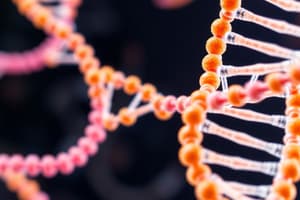Podcast
Questions and Answers
What are the four primary types of biomolecules?
What are the four primary types of biomolecules?
- DNA, RNA, proteins, lipids
- Proteins, carbohydrates, nucleic acids, uracil
- Nucleotides, deoxyribose, ribose, thymine
- Carbohydrates, nucleic acids, lipids, proteins (correct)
Which nucleic acid serves as the blueprint of an organism?
Which nucleic acid serves as the blueprint of an organism?
- mRNA
- tRNA
- rRNA
- DNA (correct)
What are the two main types of nucleic acids?
What are the two main types of nucleic acids?
- DNA and RNA (correct)
- DNA and proteins
- Carbohydrates and DNA
- Lipids and RNA
Which type of sugar is present in RNA?
Which type of sugar is present in RNA?
Which nitrogenous base is found in DNA but not in RNA?
Which nitrogenous base is found in DNA but not in RNA?
What is the structural difference between DNA and RNA?
What is the structural difference between DNA and RNA?
What is the role of DNA in genetic information storage?
What is the role of DNA in genetic information storage?
Which nucleic acid carries out the genetic information by serving as a template for protein synthesis?
Which nucleic acid carries out the genetic information by serving as a template for protein synthesis?
How do non-coding RNAs like microRNAs and long non-coding RNAs regulate gene expression?
How do non-coding RNAs like microRNAs and long non-coding RNAs regulate gene expression?
What type of modifications to RNA molecules alter their functions, stability, and interactions with proteins?
What type of modifications to RNA molecules alter their functions, stability, and interactions with proteins?
Which of the following is NOT an application of nucleic acids in research and technology?
Which of the following is NOT an application of nucleic acids in research and technology?
What technology is harnessed for genome editing purposes?
What technology is harnessed for genome editing purposes?
Flashcards are hidden until you start studying
Study Notes
Biomolecules: Exploring Nucleic Acids
Nucleic acids are one of the four primary types of biomolecules, the others being proteins, carbohydrates, and lipids. These essential building blocks of life serve as the structural and informational basis for genetic material, playing a fundamental role in cellular processes like replication, transcription, and translation.
Types of Nucleic Acids
The two types of nucleic acids are:
-
DNA (Deoxyribonucleic Acid): Found in the nucleus of eukaryotic cells and the chromosomes of prokaryotes, DNA is the blueprint of an organism. It consists of two complementary strands that are held together by chemical bonds between the nucleotides.
-
RNA (Ribonucleic Acid): Present in the nucleus and cytoplasm of cells, RNA serves as a messenger and executioner of genetic information. There are three main types: mRNA (messenger RNA), rRNA (ribosomal RNA), and tRNA (transfer RNA).
Structure and Function
Nucleic acids consist of nucleotides, which are made up of a sugar molecule, a phosphate group, and a nitrogenous base. In DNA, the sugar is deoxyribose, while in RNA, it is ribose. The nitrogenous bases in DNA are adenine (A), guanine (G), cytosine (C), and thymine (T), while RNA has uracil (U) in place of thymine. The sugar-phosphate backbone forms the double helix structure in DNA, while RNA is usually single-stranded.
DNA replication and RNA transcription produce complementary copies of the genetic information, which are then used for translation into proteins. Through the Central Dogma of Molecular Biology, genetic information flows from DNA to RNA to protein.
Biological Roles
Nucleic acids play essential roles in:
-
Genetic information storage: DNA contains the genetic code that dictates an organism's traits and functions.
-
Gene expression: RNA carries out the genetic information by serving as a template for protein synthesis.
-
Regulation of gene expression: Non-coding RNAs like microRNAs and long non-coding RNAs modulate gene expression by regulating the translation of mRNA into proteins.
-
Post-transcriptional modifications: Modifications to RNA molecules alter their functions, stability, and interactions with proteins.
Research and Applications
Nucleic acids have opened up countless avenues for research and applications:
- Understanding and manipulating the genetic code to create genetically modified organisms.
- Detecting and diagnosing diseases through molecular tests.
- Unraveling the complex interactions between genes and environment.
- Developing synthetic biology applications and gene therapy techniques.
- Harnessing the potential of CRISPR-Cas9 technology for genome editing.
In conclusion, nucleic acids serve as the genetic information and biochemical workforce of living systems. A fundamental understanding of these molecules provides insights into the inner workings of life, from the simplest organisms to the complexities of human beings.
Studying That Suits You
Use AI to generate personalized quizzes and flashcards to suit your learning preferences.




